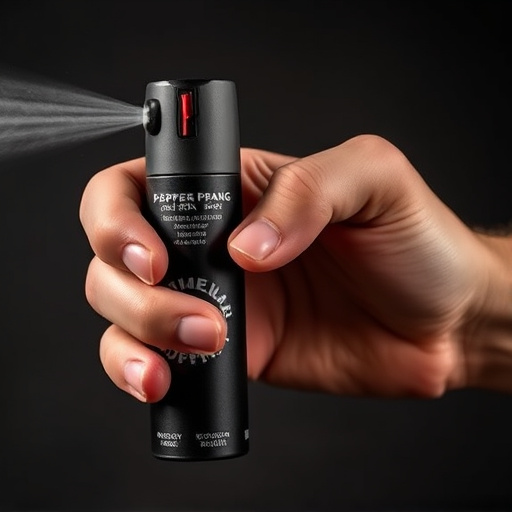Understanding pepper spray composition is key to optimizing its effectiveness and extending its shelf life, which is vital for law enforcement readiness. Storage conditions, including cool, dry environments, airtight containers, and protection from light and extreme heat, significantly impact potency and lifespan. Regular testing, rotation, and proper maintenance practices ensure officers have access to potent pepper spray, enhancing safety measures and operational efficiency through maximum resource allocation. Implementing these strategies effectively extends the shelf life of pepper spray, a crucial aspect for law enforcement agencies' long-term readiness.
“Law enforcement grade pepper spray is a crucial tool in modern policing, but understanding its shelf life and composition is essential for optimal effectiveness. This article delves into the science behind pepper spray, exploring its composition and degradation processes. We analyze various factors impacting its lifespan, from environmental conditions to storage practices. Additionally, practical strategies are presented to extend pepper spray shelf life, offering valuable insights for law enforcement agencies aiming to maximize their tactical capabilities.”
- Understanding Pepper Spray Composition and Degradation
- Factors Affecting Pepper Spray Shelf Life
- Strategies for Extending Pepper Spray Lifespan
Understanding Pepper Spray Composition and Degradation
Pepper spray, a powerful non-lethal weapon, is designed to incapacitate individuals by irritating the eyes and respiratory system. Comprehending its composition is key to understanding its effectiveness and shelf life. The primary active ingredient in pepper spray is capsaicin, derived from chili peppers. This compound creates a burning sensation when it comes into contact with mucous membranes, leading to temporary blindness, coughing, and difficulty breathing. Other components include various solvents, such as water, alcohol, and propellants, which help deliver the capsaicin.
The degradation of pepper spray over time significantly impacts its potency and performance. Exposure to heat, light, moisture, and air can accelerate this process. High temperatures can break down the capsaicin, reducing its effectiveness, while UV light can degrade the solvent, affecting the spray’s projection and coverage. Proper storage, typically in cool, dry conditions, is crucial to maintaining pepper spray’s potency and extending its shelf life. This includes using airtight containers and protecting them from direct sunlight and extreme temperatures, ensuring law enforcement officers have reliable non-lethal force options for extended periods.
Factors Affecting Pepper Spray Shelf Life
The pepper spray shelf life is influenced by several factors, each playing a crucial role in maintaining its effectiveness and potency. One of the primary considerations is storage conditions. Extreme temperatures, whether hot or cold, can significantly impact the chemical composition of pepper spray, leading to reduced efficacy over time. Proper storage in cool, dry places is essential to preserve its potency.
Additionally, exposure to light, humidity, and oxygen can accelerate degradation. Pepper spray designed for law enforcement use often contains stabilizers that prolong its shelf life by minimizing these effects. Regular testing and rotation of stock are vital practices to ensure officers have access to potent pepper spray when needed. By understanding these factors, law enforcement agencies can optimize the lifespan of their pepper spray weapons, enhancing safety measures and operational readiness.
Strategies for Extending Pepper Spray Lifespan
Extending the lifespan of pepper spray is a strategic consideration for law enforcement agencies and officers, as it ensures readiness and optimizes resource allocation. One effective method to achieve this is through proper storage. Pepper spray should be kept in its original packaging, stored in cool, dry places away from direct sunlight or heat sources. This environment prevents chemical degradation, preserving the potency of the spray. Additionally, regular maintenance checks can identify any signs of damage or leakage, ensuring the product remains usable.
Another key strategy is to implement rotation systems. Storing older batches in a separate area and using them first can help extend the overall shelf life. Law enforcement can also consider purchasing smaller, more frequent shipments instead of large bulk orders, ensuring the spray stays fresh. These simple yet effective practices significantly contribute to maximizing pepper spray’s operational effectiveness over time.
The optimal utilization of pepper spray as a law enforcement tool requires a thorough understanding of its composition, degradation processes, and influencing factors. By recognizing how environmental conditions and storage practices impact pepper spray shelf life, officers can maximize the effectiveness and longevity of their equipment. Implementing strategies to extend pepper spray lifespan, such as proper storage, maintenance, and inventory management, ensures that law enforcement agencies remain prepared with reliable tools for crowd control and self-defense. Through these measures, pepper spray shelf life extension becomes a practical and essential aspect of tactical planning.
